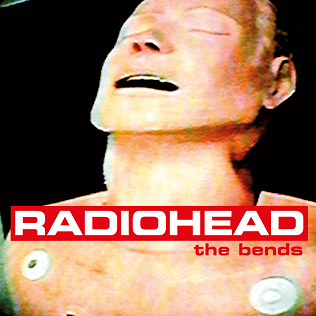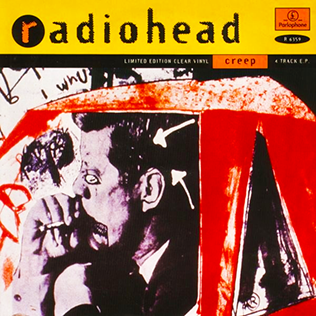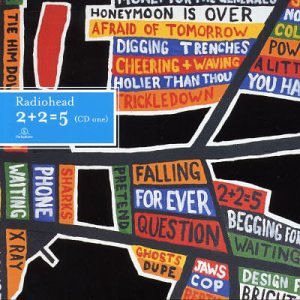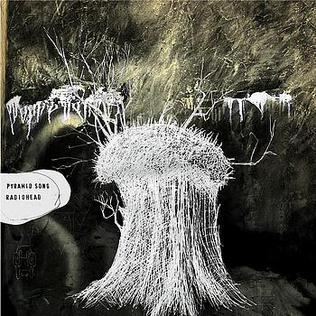Radiohead are an English rock band formed in Abingdon, Oxfordshire, in 1985. They comprise Thom Yorke ; brothers Jonny Greenwood and Colin Greenwood (bass); Ed O'Brien ; and Philip Selway. They have worked with producer Nigel Godrich and cover artist Stanley Donwood since 1994. Radiohead's experimental approach is credited with advancing the sound of alternative rock.

Amnesiac is the fifth studio album by the English rock band Radiohead, released on 30 May 2001 by EMI. It was recorded with the producer Nigel Godrich in the same sessions as Radiohead's previous album Kid A (2000). Radiohead split the work in two as they felt it was too dense for a double album. As with Kid A, Amnesiac incorporates influences from electronic music, 20th-century classical music, jazz and krautrock. The final track, "Life in a Glasshouse", is a collaboration with the jazz trumpeter Humphrey Lyttelton and his band.

The Bends is the second studio album by the English rock band Radiohead, released on 13 March 1995 by Parlophone. It was produced by John Leckie, with extra production by Radiohead, Nigel Godrich and Jim Warren. The Bends combines guitar songs and ballads, with more restrained arrangements and cryptic lyrics than Radiohead's debut album, Pablo Honey (1993).

Hail to the Thief is the sixth studio album by the English rock band Radiohead. It was released on 9 June 2003 through Parlophone internationally and a day later through Capitol Records in the United States. It was the last album released under Radiohead's record contract with EMI, the parent company of Parlophone and Capitol.

"Paranoid Android" is a song by English alternative rock band Radiohead, released as the lead single from their third studio album, OK Computer (1997), on 26 May 1997. The lyrics were written by singer Thom Yorke following an unpleasant experience in a Los Angeles bar. The song is over six minutes long and contains four sections. The name is taken from Marvin the Paranoid Android from the science fiction series The Hitchhiker's Guide to the Galaxy.

My Iron Lung is the third EP by the English rock band Radiohead, released on 26 September 1994 by Parlophone Records in the UK and by Capitol Records in the US. It was produced by Radiohead, John Leckie and Nigel Godrich. It marked Radiohead's first collaborations with Godrich and the artist Stanley Donwood, who have worked on every Radiohead release since.

"High and Dry" and "Planet Telex" are songs by the English rock band Radiohead. They were released as a double-A side single from Radiohead's second album, The Bends (1995), on 27 February 1995.

"Knives Out" is a song by the English rock band Radiohead, released as the second single from their fifth album, Amnesiac (2001). It features lyrics about cannibalism and guitars influenced by the Smiths. "Knives Out" received positive reviews and reached number 13 on the UK Singles Chart and number one on the Canadian Singles Chart. The music video was directed by Michel Gondry.

"Creep" is the debut single by the English rock band Radiohead, released on 21 September 1992. It was included on Radiohead's debut album, Pablo Honey (1993). It features "blasts" of guitar noise by Jonny Greenwood and lyrics describing an obsessive unrequited attraction.

"Fake Plastic Trees" is a song by the English rock band Radiohead, released on their second album, The Bends (1995). It was the third single from The Bends in the UK, and the first in the US. It reached the top 50 on the UK Singles Chart, the New Zealand Singles Chart, the US Modern Rock Tracks chart and the Canadian Rock/Alternative chart.

"Karma Police" is a song by the English rock band Radiohead, released on 25 August 1997, as the second single from their third studio album, OK Computer (1997). It reached number one in Iceland and number eight on the UK Singles Chart. In the US, it reached number 14 on the US Modern Rock Tracks chart. It was included on Radiohead: The Best Of (2008).

The English rock band Radiohead have released nine studio albums, one live album, five compilation albums, one remix album, nine video albums, seven EPs, 32 singles, and 48 music videos. Their debut album, Pablo Honey, released in February 1993, reached number 22 in the UK, receiving platinum certifications in the UK and US. Their debut single, "Creep", remains their most successful, entering the top 10 in several countries. Their second album, The Bends, released in March 1995, reached number four in the UK and is certified triple platinum.

"2 + 2 = 5" is a song by the English rock band Radiohead. It is the opening track to their sixth studio album Hail to the Thief (2003), and was also released as the album's third and final single. It reached number two on the Canadian Singles Chart, number 12 on the Italian Singles Chart, and number 15 on the UK Singles Chart. It was included in Radiohead: The Best Of (2008).

"Go to Sleep" is a song by the English rock band Radiohead, released as the second single from their sixth studio album Hail to the Thief (2003) on 18 August 2003. It reached number two on the Canadian Singles Chart, number nine on the Italian Singles Chart, and number 12 on the UK Singles Chart.

"Pyramid Song" is a song by the English rock band Radiohead, released as the lead single from their fifth studio album, Amnesiac (2001), in May 2001. It features piano, strings, an unusual "shuffling" rhythm and lyrics inspired by the Egyptian underworld.

In Rainbows is the seventh studio album by the English rock band Radiohead. It was self-released on 10 October 2007 as a pay-what-you-want download, followed by a physical release internationally through XL Recordings on 3 December 2007 and in North America through TBD Records on 1 January 2008. It was Radiohead's first release after their recording contract with EMI ended with their album Hail to the Thief (2003).

"Burn the Witch" is a song by the English rock band Radiohead, the lead single from their ninth studio album, A Moon Shaped Pool (2016). It features a string section playing with guitar plectrums, producing a percussive sound. Radiohead first worked on the song during the sessions for their fourth album, Kid A (2000), and developed it for over a decade.

A Moon Shaped Pool is the ninth studio album by the English rock band Radiohead. It was released digitally on 8 May 2016, with a retail release on 17 June 2016 through XL Recordings. It was produced by Radiohead's longtime collaborator Nigel Godrich.

The Smile are an English rock band comprising the Radiohead members Thom Yorke and Jonny Greenwood with Tom Skinner (drums). Critics likened them to Radiohead, with more jazz, krautrock and progressive rock influences and a looser, wilder sound.


















